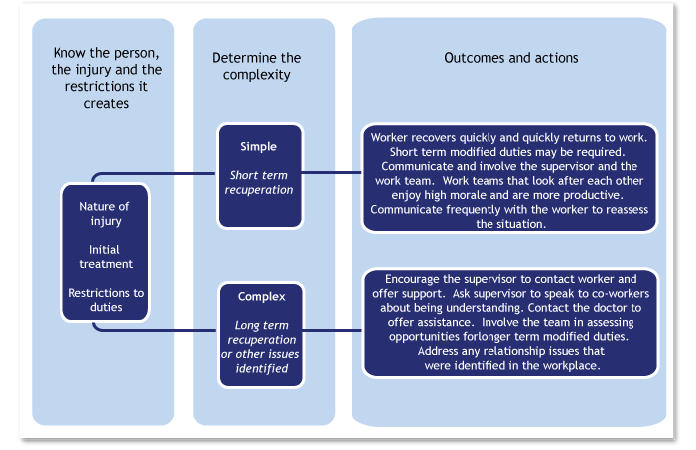 In some instances a worker may not report the injury face to face. Many conditions become worse the following day and are reported at that time. In some instances a worker may not report the injury face to face. Many conditions become worse the following day and are reported at that time.
Encourage reporting, but don't be surprised if you hear about a problem a day or two after it started.
Minor sprains and strains are common and are a normal part of life. If all minor aches were reported, companies would need a full time staff member just to deal with the paperwork.
|
Within 48 hours the initial conversations with the worker, the doctor and the supervisor have taken place. Identify what further information you need to plan your next steps and move forward. Set up communication channels, plan the approach, get things happening. As the RTW Coordinator we seek to understand:
1. What is the nature of the injury?
Does the worker have mild pain, moderate or severe pain? Are they coping with / managing their pain? What does the doctor say is wrong with them? Do they need further tests / investigations? Do they understand the nature of their condition?
Discuss these questions with the worker to gain an understanding of their condition.
|
2. Are restrictions necessary?
Note: work can be an important part of therapy
| • | What are the worker’s expectations regarding: |
| ▪ | Duties they can do at work – normal or modified normal duties |
| ▪ | Return to work date if off work? |
| ▪ | What is the treater’s view of restrictions the injury imposes? |
| ▪ | What is the treater’s estimate of the recuperation period? |
|
3. What other factors need to be considered?
| • | Assess the employee’s general personality and outlook. |
| • | What is the quality of the worker’s relationship to their job, supervisor and co-workers? |
| • | Have there been recent issues that impact on goodwill? |
| ▪ | Industrial relations issues |
| ▪ | Other long term cases that may have influenced the employee’s perception |
| ▪ | Home or personal factors |
|
4. Communication
| • | The extent of communication depends on the complexity of the situation |
| ▪ | Keep a loop going with the supervisor and employee |
| ▪ | Ensure there is regular and productive communication |
| ▪ | Get involved if there is not |
| • | Complex case - Who else needs to be involved? |
| ▪ | Senior management – a call from a senior manager / company owner to inquire after the person’s well being makes a huge difference. The worker feels supported, co workers understand the importance of the situation and the supervisor listens differently. |
| ▪ | HR should be involved in cases: |
| o | There have been performance management issues |
| o | Where other assistance may be needed, such as time off work for other reasons, pay concerns, an Employee Assistance Program needs to be used |
| ▪ | Production manager can help identify other duties |
 Communicate Communicate
In addition to your personal contact, ensure messages of support are sent to the injured worker. e.g flowers, or a card signed by management and co-workers. If possible have a senior manager contact the person by telephone.
In conversation, ask questions and use active listening to keep communication channels open. Set a time when you will follow up again. Assure the person that you are there to help when the time is right to discuss returning to work.
|
|
5. Duties
| • | Check with employee whether the duties they are doing are satisfactory. Are they coping, do they need anything else, are they being looked after. |
If, for example, the worker has a pre-existing issue with their supervisor, take this into consideration. Dealing with these matters constructively will ensure the worker feels understood and supported. It also creates the opportunity to improve the workplace environment that the worker will return to. Knowing the personality and attitudes of the worker help identify the best way to communicate with them and what boundaries to set to protect the team from a difficult worker.

|
 What's next?
What's next?
Prediction Tools








![]() What's next?
What's next?